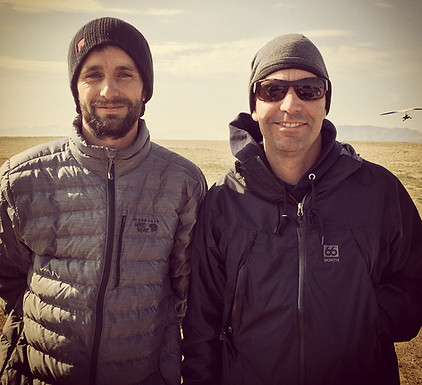
DELIVERY TIMEs (as of 4/15/24)
Wings //10-12 WEEKS
LINESETS // up to 4-6 WEEKS
all sliders // 4-6 WEEKS
1-888-24-Fluid X 0
1-888-243-5843 X 0
mon-fri 9am to 5pm
EMAIL MISSY@FLUIDWINGS.COM TO SCHEDULE
A LITTLE BACKGROUND
Kevin Hintze began paragliding at age 16 and immediately fell in love with flight. He was one of the early pioneers of aerobatic paragliding in the USA and taught at the Point of the Mountain in Utah for over 10 years. Kevin is also a licensed general aviation pilot. He began tinkering with paraglider wings, making significant changes to wings he owned. He soon began flight testing for several major paragliding companies in between instructing and flight school commitments.
Scott Roberts began skydiving in 1998 and by 2001 he was a competitive canopy pilot who went on to compete in 3 world championships and countless other top-level competitions as a member of Team FASTRAX and Slipstream Airports. Scott has a master’s degree in engineering with over 20 years of design experience.
A MEETING OF MINDS
In 2007 Scott and Kevin met through speed flying. Kevin was instructing paragliding and Scott was doing contract work for another major parachute company for the release of a speed wing. They became fast friends and began to share knowledge - Scott sharing skydiving with Kevin and Kevin sharing paragliding/speed flying with Scott. Shortly after that they began what became to be known as Project Mayhem.
PROJECT MAYHEM
Project Mayhem started with what seemed like a stunt: to jump out of an airplane with a paraglider wing and survive. The project quickly evolved into developing a way to repeatedly jump aerobatic (acro) paragliders out of airplanes. It evolved over 4 years and involved some serious safety, rigging and aerodynamic challenges. In 2012 they achieved their goal and were able to successfully jump paragliding wings out of airplanes in a repeatable manner. This system of sub-components have yet to come to market, however some might have heard of parts/sections such as the skydiving hip harness. With that under their belt Scott and Kevin wondered: “What's next?”
In 2011 Scott was hurt in a serious paragliding accident that left him bedridden for over 4 months and made continued competition as a top-level canopy pilot impossible. He decided to use this downtime to take several courses in aerodynamics, and studied full-time during his recuperation and well beyond. He also found a paraglider designer in Spain that he was able to apprentice under and learned the details of ram air wing design. Scott also spent a good deal of time researching and learning how to perform computational fluid dynamics, which is nerd for computer simulations of fluid flow (yes, Scott speaks fluent nerd). When combined with Kevin’s experimental-based approach they soon realized that they had a magic combination.
THE EARLY TIMES
After Project Mayhem the two wondered what was next. A paraglider of course! Scott set off to work designing and building it. In late 2012 they had a prototype of the Rubicon. They tested it in Utah under Kevin’s lead and found it to not only be safe and effective but really fun and enjoyable to fly. They both knew that they wanted to make more wings and make this a full-time venture. They brought in others to help - Shane Shaffer and eventually Lucas Alderette - and Fluid Wings was formed. They rented their first space in DeLand, Florida, in 2013 and began the research & development to produce more paragliders and parachutes immediately. With Scott's background in competitive canopy piloting it became obvious that a high-performance competition wing was in the future.
THE BIRTH OF THE HK
The Hooker Project (named as a sexy play on hook turns) was born in April 2013 and in the first month they had 3 different prototypes. Then the hard work of testing the wing began (not all successful... :) This project continued for over 3 years and had 16 entirely different designs with over 20 prototypes and countless minor changes such as lines or swapping out end/center cells etc. (there were 50+ revisions to lines alone). The project was led by Scott and was continuous during the development of both the Prime and Helix wings.
Side note: In late 2014 they had something that had most of the characteristics that they wanted and had significant performance advantages over conventional cross-braced wings on the market at the time. However, they found that the wing required a precise level of “active” piloting similar to that of paragliders. They recognized that skydiving pilots were not trained for, nor accustomed to, that type of flying and decided that the wing needed to fly like other skydiving wings so they went back to the drawing board and started from scratch one more time to find that balance.
In late 2015, the final revision on the HK wing began to look like they had a serious contender for a production wing. They built a few wings for the core group of Fluid Wings pilots to use in competition and made the necessary tweaks to make this a viable wing that could hold its own against any competition wing on the market. Once all the sizes were sorted out and tested the wing was released in spring for 2016.
THE FUTURE OF FLUID COMPETITION WINGS
The HK is part of an ever-evolving project that will supply pilots with a “race” concept competition wing. R&D is ongoing and the wing will be periodically updated to reflect the current state-of-the-art. There are no secret handshakes; no special invitations or exclusive club membership needed to acquire an HK. All that is required is the commensurate skills to fly it safely and a desire to fly a top-notch, cutting-edge wing.
Fluid Wings already has the next step in the Hooker Project. It is undergoing R&D and we know you’ll love it when becomes available.




